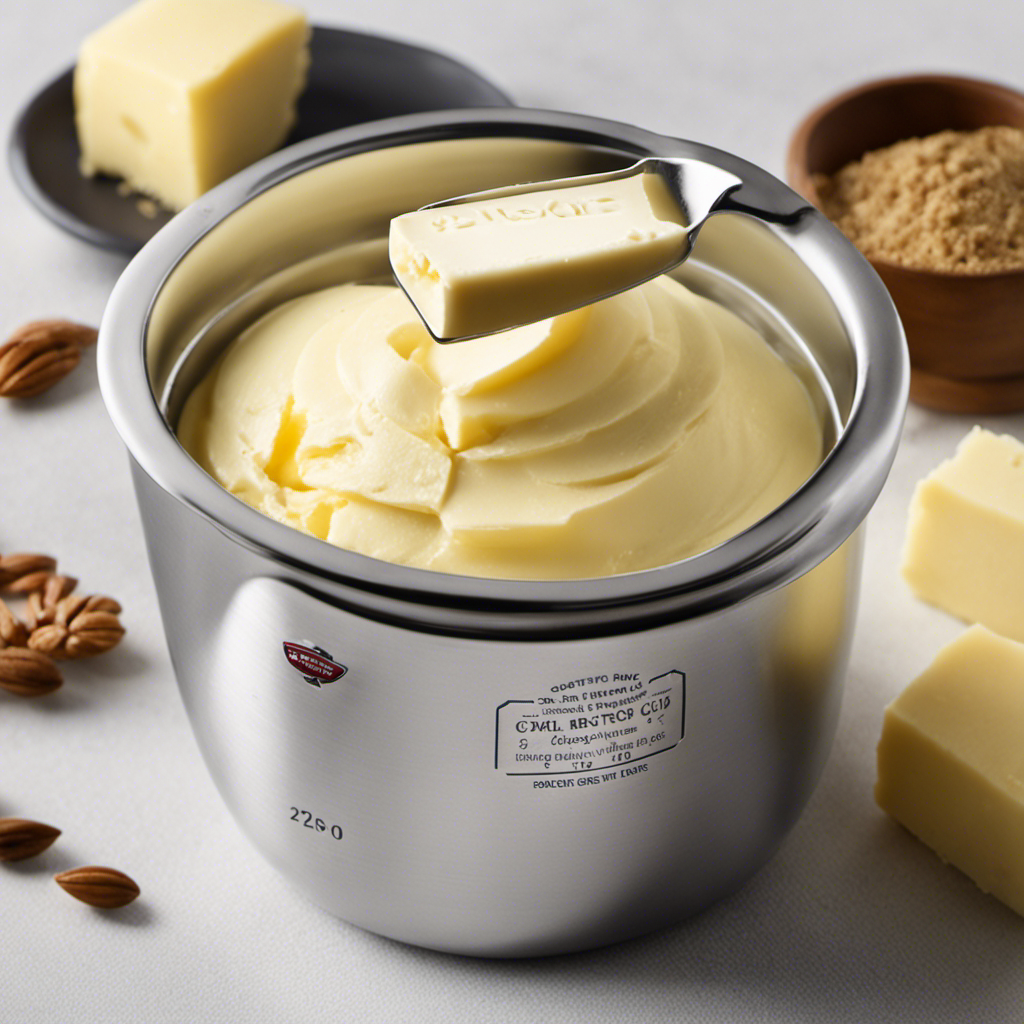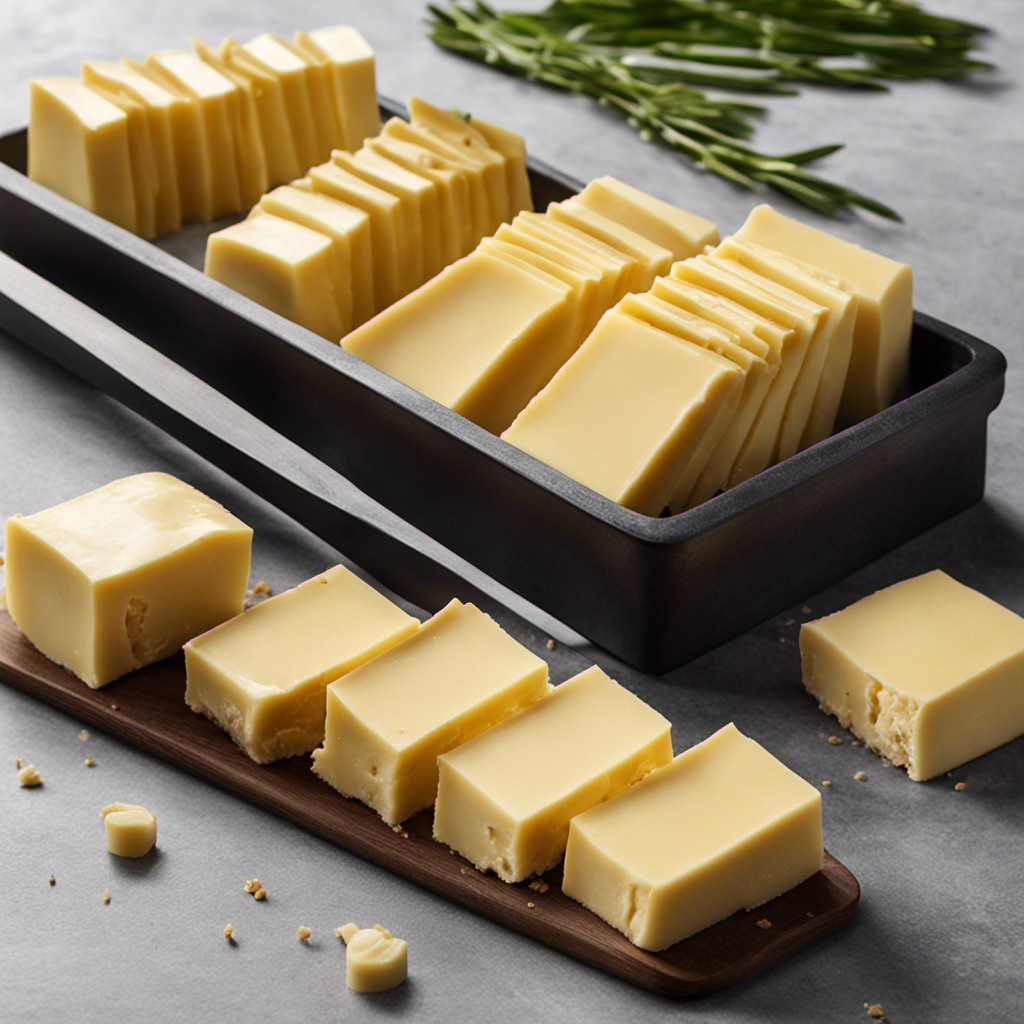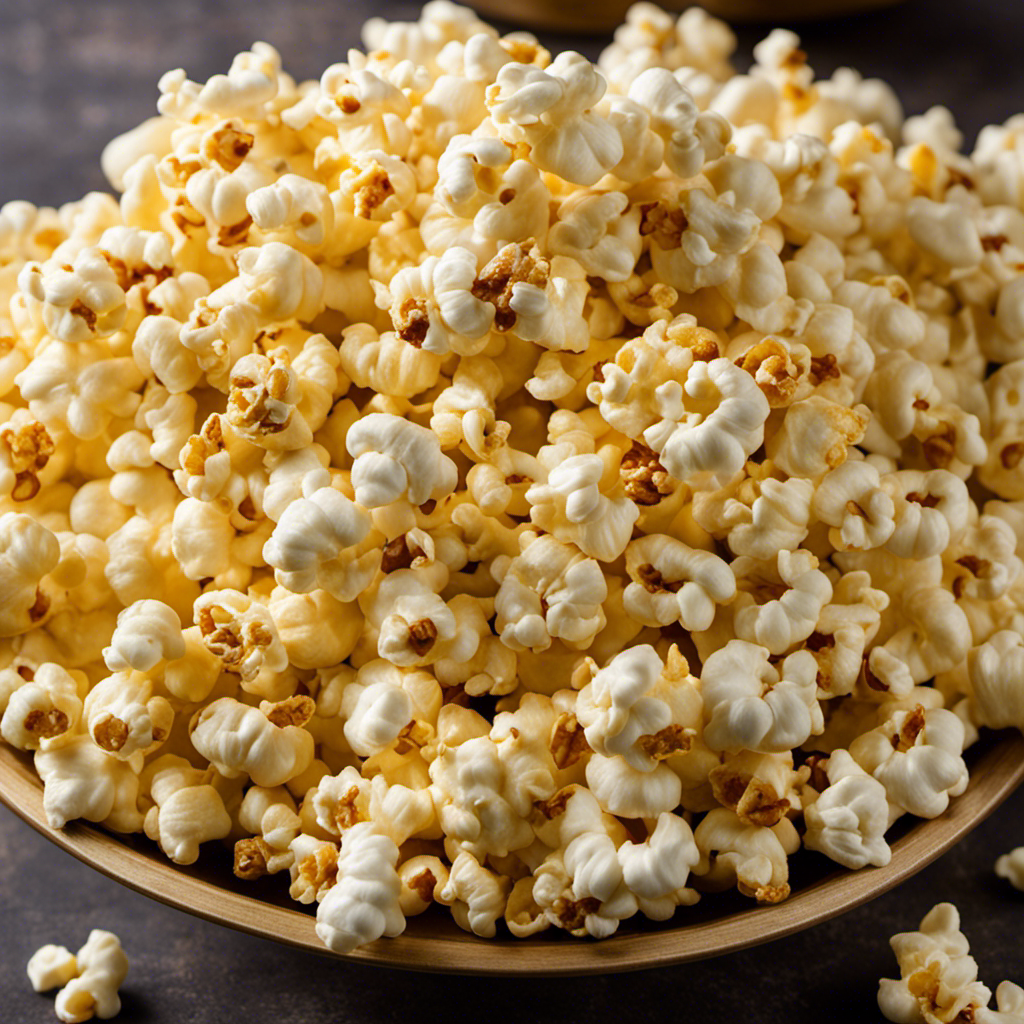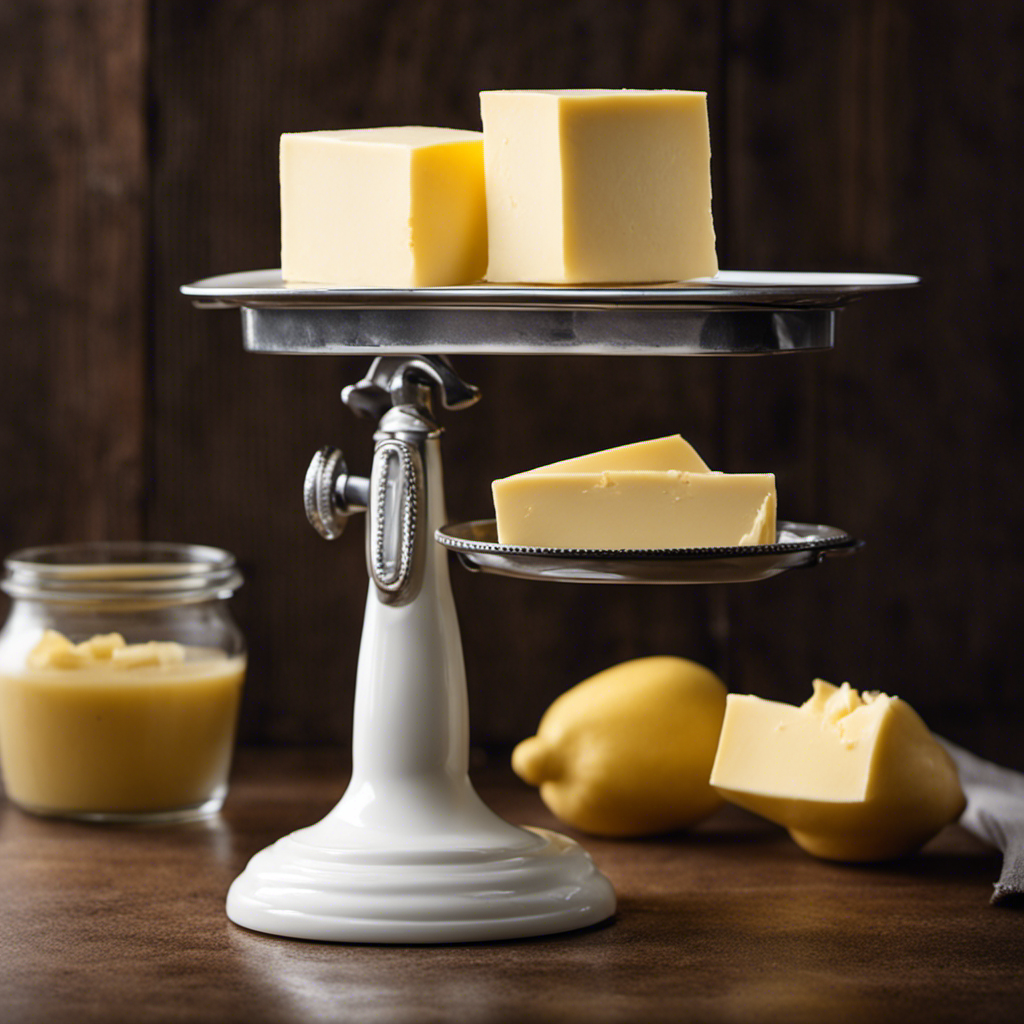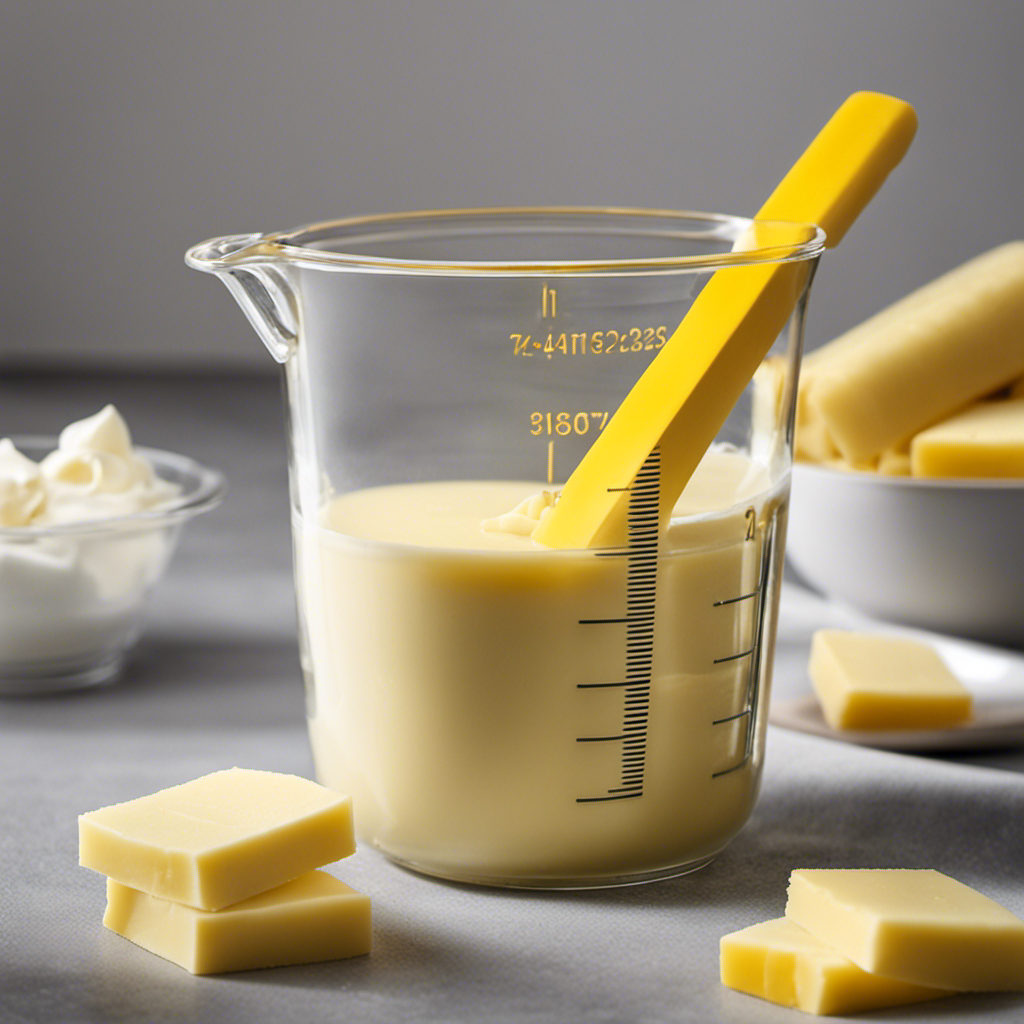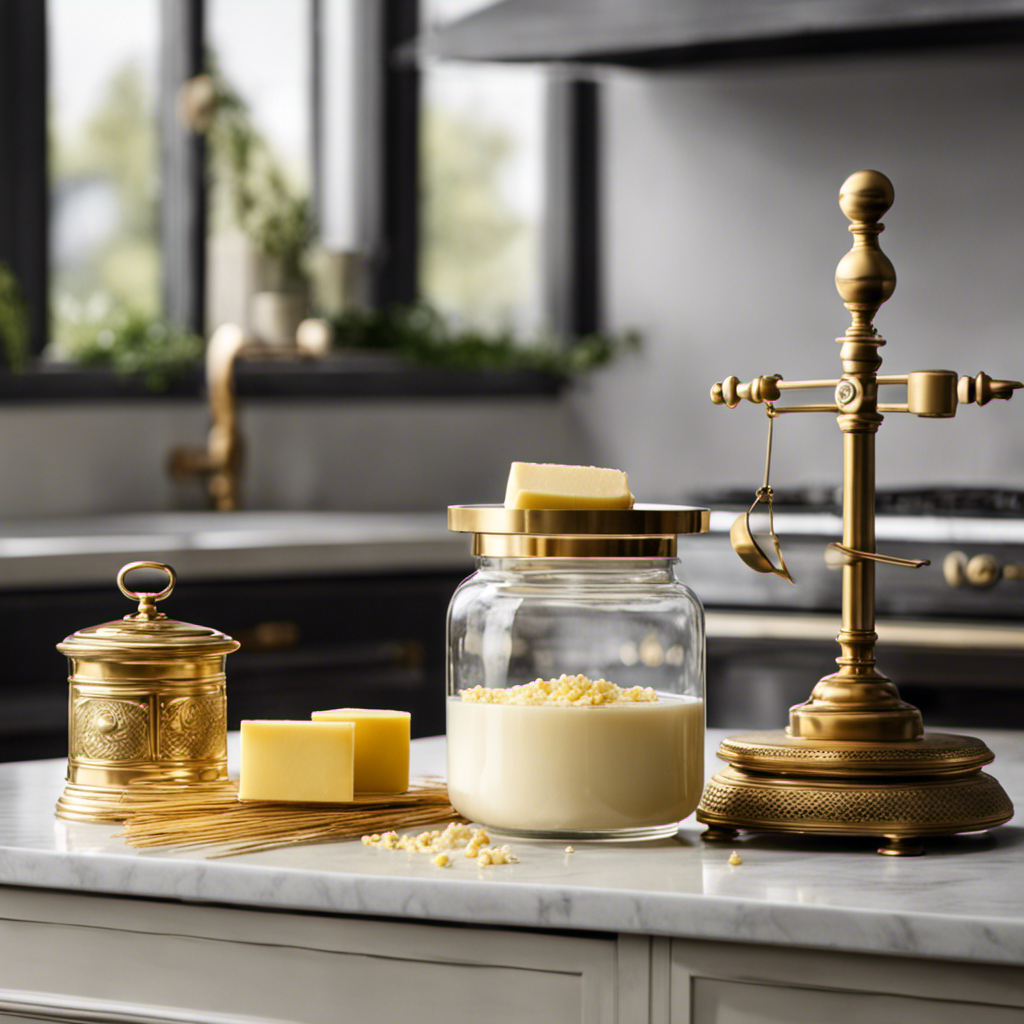As someone passionate about cooking, I regularly find myself contemplating the exact amounts needed in the kitchen. A common question that comes up is, ‘How many grams does half a cup of butter weigh?’ This straightforward but vital question is essential for mastering the art of cooking.
In this article, we will explore the conversion from cups to grams for butter, delving into the importance of precision and uncovering the versatility of this beloved ingredient.
Prepare to master the art of butter conversions and unlock the secrets to precise measurements.
Key Takeaways
- The density of butter is approximately 0.95 grams per milliliter.
- Converting cups to grams for butter is not precise due to varying densities, but 1 stick or 1/2 cup of butter is equivalent to 113 grams.
- Precision in measuring butter is crucial for achieving consistent results in baking.
- Alternative butter substitutes, such as margarine, coconut oil, avocado, and others, offer lower saturated fat and cholesterol options suitable for specific dietary needs.
Converting Cups to Grams: Butter
To convert half a cup of butter into grams, you’ll need to know the specific conversion rate. Understanding butter density is crucial in this process.
The density of butter can vary depending on factors such as temperature and brand, but on average, it is around 0.95 grams per milliliter. Since there are approximately 236.59 milliliters in a cup, we can calculate that half a cup of butter weighs approximately 112.8 grams.
It’s important to note that converting cups to grams is not a precise measurement, as the density can differ. To get a more accurate conversion, you can first convert cups to ounces using the standard conversion rate of 1 cup equals 8 ounces, and then convert ounces to grams using the rate of 1 ounce equals 28.35 grams.
Understanding butter measurements allows for more precise and consistent results in baking and cooking.
Understanding Butter Measurements
You can easily understand how much butter you need by knowing the measurement for half a cup. When it comes to precision in cooking, accurate measurements are crucial. Butter is a common ingredient in many recipes, and knowing how much to use can make or break a dish.
However, it’s important to note that the amount of butter needed may vary depending on its form. Here are some different forms of butter and their corresponding measurements:
- Solid Butter: Half a cup of solid butter weighs approximately 113 grams.
- Melted Butter: Half a cup of melted butter weighs approximately 113 grams.
- Softened Butter: Half a cup of softened butter weighs approximately 113 grams.
- Sliced Butter: Half a cup of sliced butter weighs approximately 113 grams.
The Importance of Precision: Half a Cup
When it comes to baking, precision is key. Exact butter measurements are crucial for achieving consistency in baking, which in turn ensures recipe accuracy and success.
Understanding the precise measurement of half a cup of butter can make all the difference in achieving the desired texture and taste in your baked goods.
Exact Butter Measurements
Half a cup of butter is equivalent to approximately 113 grams. Converting butter measurements can be tricky, but knowing the equivalents can make baking a breeze. Here are some helpful conversions to keep in mind:
- 1 stick of butter (1/2 cup) = 113 grams
- 1/4 cup of butter = 57 grams
- 1 tablespoon of butter = 14 grams
- 1 teaspoon of butter = 5 grams
By knowing these butter measurement equivalents, you can easily adjust recipes based on your preferred unit of measurement. Whether you’re using cups, grams, tablespoons, or teaspoons, you’ll be able to achieve the desired consistency in your baked goods.
Consistency is key in baking, as it ensures that your recipes turn out just right every time. Now, let’s dive into the importance of consistency in baking.
Consistency in Baking
To achieve consistent results in baking, it’s important to carefully measure and follow recipes. Precision in cooking is key, as even the slightest variation in ingredients can greatly affect the outcome of a baked good. One of the most common baking mistakes is not measuring ingredients accurately.
When it comes to baking, precision is everything. Inaccurate measurements can lead to a dense cake, flat cookies, or a bread that doesn’t rise properly. To ensure accuracy, it is recommended to use a kitchen scale for measuring ingredients by weight, rather than relying solely on volume measurements like cups and tablespoons.
This will guarantee that you are using the exact amount of each ingredient, resulting in consistently delicious and perfectly baked treats.
Recipe Accuracy and Success
You can ensure recipe accuracy and success by following the precise measurements and instructions. Here are four tips to help you achieve the best results:
-
Use a kitchen scale: Measuring ingredients by weight ensures accuracy and consistency in your recipes. This is especially important for ingredients like flour, where the volume can vary depending on how it’s packed.
-
Level off dry ingredients: When measuring ingredients like flour or sugar, use a straight edge (like the back of a knife) to level off the measuring cup. This ensures that you’re using the correct amount and prevents any excess from throwing off the balance of your recipe.
-
Spoon and level liquids: For liquids like milk or oil, use a liquid measuring cup and make sure to pour it to the desired line. Avoid estimating or eyeballing the amount, as this can lead to inaccuracies.
-
Follow the recipe exactly: Pay attention to the order of ingredients, mixing times, and cooking temperatures specified in the recipe. Any deviations can affect the outcome of your dish.
Grams: the Universal Unit of Measurement
Grams are commonly used as the universal unit of measurement for various ingredients in recipes. They provide a precise and accurate way to measure ingredients, ensuring consistency and success in cooking. As a home cook, I find it essential to understand how to convert units to grams, especially when following recipes from different sources that may use different measurement systems. Converting units to grams allows for easy comparison and ensures that the correct amounts are used. To help you with this, I have created a table below that shows common conversions from cups to grams for some ingredients:
| Ingredient | Cups (US) | Grams |
|---|---|---|
| Butter | 1 | 227 |
| Flour | 1 | 125 |
| Sugar | 1 | 200 |
| Milk | 1 | 240 |
Butter: a Versatile Ingredient
Butter is an essential ingredient in many recipes, and it’s important to have accurate measurement conversions to ensure the right balance of flavors and textures.
In this discussion, I will explore the various ways to convert butter measurements from grams to cups and vice versa, providing precise information for optimal cooking and baking.
Additionally, I will delve into the world of butter substitutes and alternative options, offering insights on healthier alternatives and their impact on the final outcome of your culinary creations.
Butter Measurement Conversions
To convert half a cup of butter into grams, simply multiply the measurement by the appropriate conversion factor. Here’s a step-by-step guide to converting butter measurements:
-
Determine the conversion factor: The conversion factor for butter is 227 grams per cup. This means that there are 227 grams in one cup of butter.
-
Calculate the grams: Multiply the measurement of half a cup of butter by the conversion factor. In this case, half a cup is equal to 0.5 cups. So, 0.5 x 227 grams = 113.5 grams.
-
Round the result: Since grams are usually measured in whole numbers, round the result to the nearest gram. In this case, 113.5 grams would be rounded to 114 grams.
-
Final result: Half a cup of butter is approximately equal to 114 grams.
Butter Substitutes and Alternatives
When it comes to butter substitutes and alternatives, there are plenty of options available that can provide similar taste and texture while offering additional health benefits. These alternatives are particularly useful for those who are lactose intolerant or following a vegan diet. Here is a table comparing some popular butter alternatives:
| Butter Alternative | Description | Health Benefits |
|---|---|---|
| Margarine | Made from vegetable oils, margarine is a common butter substitute. It is lower in saturated fat and cholesterol, making it a healthier option. | |
| Coconut Oil | Coconut oil is a versatile substitute that can be used in both cooking and baking. It contains medium-chain fatty acids, which are easily digestible and can provide a quick source of energy. | |
| Avocado | Avocado can be mashed and used as a spread or added to recipes as a butter replacement. It is rich in healthy fats and provides a creamy texture. |
These butter alternatives offer a range of health benefits, such as reduced saturated fat content, increased healthy fats, and potential energy boosts. Experimenting with these alternatives can help individuals find the perfect substitute for their specific dietary needs.
Mastering Butter Conversions
I’ll show you how to master conversions for butter. Converting measurements can be tricky, but with the right knowledge, you’ll be able to confidently navigate any recipe.
Here’s a handy butter conversion chart to help you out:
-
Stick of Butter: A stick of butter typically weighs 113 grams or 1/2 cup.
-
Tablespoon of Butter: One tablespoon of butter is equivalent to 14 grams or 1/8 cup.
-
Teaspoon of Butter: There are approximately 4.7 grams of butter in one teaspoon.
-
Pound of Butter: A pound of butter weighs 454 grams or 2 cups.
By referring to this chart, you can easily convert between different measurements of butter. Whether you need to scale up or down a recipe, understanding these common butter measurements will ensure accurate and delicious results.
Tips and Tricks for Measuring Butter Accurately
Measuring butter accurately can be simplified with a few tips and tricks. When it comes to precise baking techniques, getting the right amount of butter is crucial. However, not everyone has a kitchen scale to measure butter in grams. That’s where conversions come in handy. Here are some common measurements for butter alternatives:
| Measurement | Equivalent |
|---|---|
| 1 cup | 226 grams |
| 1/2 cup | 113 grams |
| 1/4 cup | 57 grams |
| 1 tablespoon | 14 grams |
| 1 teaspoon | 5 grams |
Frequently Asked Questions
Can I Use Any Type of Butter for the Measurements Provided in the Article?
Yes, you can use alternative types of butter for the measurements provided in the article. To measure butter without a scale accurately, you can use the displacement method or a measuring cup with markings for tablespoons.
Are There Any Recommended Substitutes for Butter if I Don’t Have It on Hand?
When I don’t have butter on hand, I find that using margarine or coconut oil can work as substitutes. They have similar textures and flavors, making them good alternatives to butter in recipes.
How Does the Temperature of the Butter Affect the Accuracy of the Measurements?
The temperature of the butter can impact the accuracy of measurements in a recipe. Softened butter at room temperature may result in a different measurement compared to cold butter, which can affect the outcome of the recipe.
Are There Any Specific Techniques for Measuring Butter Accurately Without a Scale?
Measuring butter accurately without a scale can be tricky, but with practice it becomes second nature. Using specific techniques like the displacement method or measuring by tablespoons can ensure accurate butter measurements without a scale.
Can I Use the Same Conversion Measurements for Salted and Unsalted Butter?
Yes, the same conversion measurements can be used for both salted and unsalted butter. However, it’s important to note that the type of butter can affect the accuracy of the measurements due to variations in moisture content.
Conclusion
In conclusion, understanding the precise measurements of butter is crucial for any culinary enthusiast. Converting half a cup of butter into grams provides the accuracy needed for perfect recipes.
By mastering butter conversions, one can unlock the versatility of this ingredient, creating delectable dishes. Remember, precision is key when measuring butter.
So, whether you’re baking a flaky pie crust or whipping up a velvety sauce, use the universal unit of grams to achieve culinary greatness. Measure meticulously, and let the magic of butter elevate your cooking to new heights.
